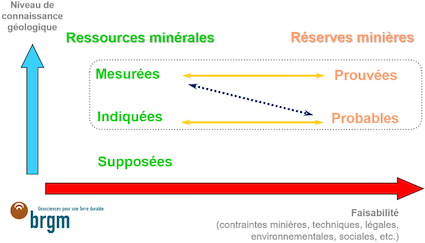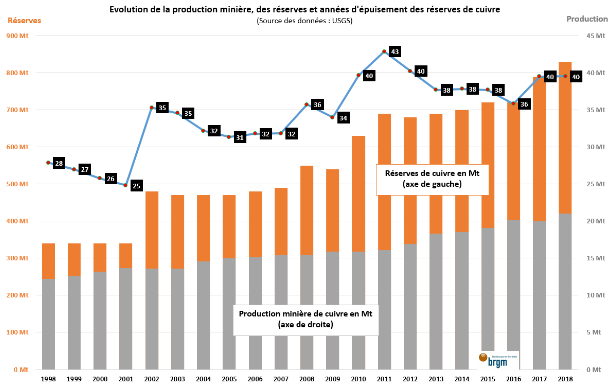Why is it so difficult to make projections regarding the duration of mineral reserves?¶
Authors and date
- Submitted on: April 23th 2021
- Antoine Boubault, Researcher in Industrial Ecology and Mineral Resource Economics (BRGM)
Introduction¶
Our senses allow us to know quickly the material elements constituting our direct environment: trees' wood, cities' concrete, mountains' rock, rivers' water, deserts' sands, etc. On the other hand, our senses are not very well adapted to inform us about underground material elements. Gaining this knowledge requires determining possible relationships between what we observe at the Earth's surface and what is underneath.
Geology and all its related specialties allow us to better understand and characterize the history, state and evolution of geological formations. Finding mineral resources requires the ability to observe the surface and understand the geological phenomena at work, especially those that concentrate chemical elements and form mineral deposits.
From resources to reserves¶
During the exploration phase, mining companies look for clues that hint the presence of an anomalous concentration of a mineral. They then undertake drillings, measurements, and numerical modelling to roughly estimate the resource potential. Once the location of a potential deposit has been determined, mining companies continue their investigations in order to characterize it with sufficient details.
At a later stage, feasibility of the mining project needs to be demonstrated in order to begin operation. Companies must convert resources to reserves, that is to prove that the identified resources can be properly extracted, processed and then sold while respecting all legal frameworks and ensuring the profitability of the project. It is at this stage that many parameters come into play, requiring technical and costly investigations. By advertising probable or proven reserves, a mining company will attract investors gather the necessary funds to construct the mine.

Once the project is in operation, other measurement campaigns may be carried out to convert resources to additional reserves. However, it is pointless for a mining operator to explore all neighbouring deposits as long as the current deposit is enough to guarantee several decades of production. It is therefore not possible to consider mineral reserves as a fixed stock. It is also difficult to predict the evolution of reserves because they not only rely on future discoveries but also on the evolution of feasibility parameters, which in turn depend on the price of the extracted materials.
An example: copper¶
If we take the example of copper, mineral reserves were estimated in year 2000 at 25 years at the production rate of that year. Since then, mine production has increased by over 2%/year while reserves have also increased, taking the 2018 reserves up to 40 years at the 2018 production rate. Even if the reserves-to-production ratio cannot be used as a proxy for mineral depletion, it is recognized that an exponentially growing copper production cannot be sustained forever. Hence, there will be a stabilization or even a reduction in primary production in the coming years, in favor of secondary resources.

Figure 2: Evolution of mine production, reserves and the reserves-to-production ratio for copper. 1
Sources¶
-
M. Leguérinel, M. Le Gleuher. Le cuivre : revue de l’offre mondiale en 2019. Rapport final. BRGM/RP-69037-FR. BRGM, 2019. Available on infoterre.brgm.fr ↩